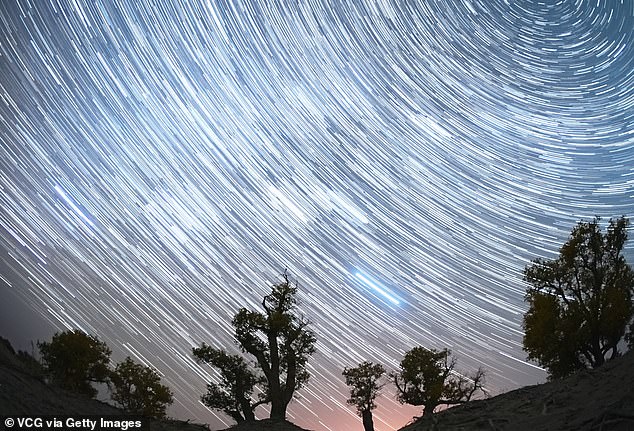Mysterious ‘explosive’ sound from a ‘UFO’ over New England shook homes and rattled windows – and a Harvard physicist believes he has located the source
>
New England residents reported hearing a “strange” sound on the evening of October 20, shaking homes and shattering windows for at least 12 seconds.
Harvard University’s astronomical instruments recorded the noise and found that it did not resemble anything coming from birds, planes or wind.
Alien-hunting physicist and former Harvard University chief of astronomy Avi Loeb to investigate the source of the “unidentified flying object.”
Loeb determined that the UFO released explosive energy equivalent to 2,400 pounds of TNT detected from a distance of more than 10 miles.
The sound was moving at 1,115 feet per second when it was detected by an observatory in Cambridge, Massachusetts.
Loeb determined that the energy source likely came from the explosion of a mile-wide meteorite during the orionids shower that peaked in the area on October 21.
Avi Loeb determined that the UFO released explosive energy equivalent to 2,400 pounds of TNT that was detected from a distance of more than 10 miles. The sound was moving at 1,115 feet per second when it was detected by an observatory in Cambridge, Massachusetts

The Loeb Galileo Project Observatory recorded the boom using a giant, ultra-sensitive microphone (pictured) that it mounted on the roof of a building on Harvard’s campus.
Loeb’s Project Galileo observatory recorded the boom using a giant, ultra-sensitive microphone that he mounted on the roof of a building on Harvard’s campus.
Andy Meade, who designed and built the system, contacted Loeb on October 21 after he noticed something strange picked up by the sensors.
“I started receiving messages this morning about a ‘viral’ sound that was being heard throughout New England,” Mead said in the memo.
“It’s worth noting that the Mount Washington Observatory put out a post about this as they had a lot of inquiries.
“This post now has over 4,000 reactions, 1,000 comments and 751 shares, many of whom have heard the audio and are following the story.”
Reports came from both states, traveling through Mount Washington, Boothbay Harbor, Main and Sturbridge, where people heard an explosion above their homes around 7:43 PM ET on October 20.

Andy Mead, who designed and built the AMOS system, contacted Loeb on October 21 after noticing a social media post about something strange in New Hampshire (pictured)
He told Med Loop that he examined AMOS, and found a “very interesting sound” that lasted for 12 seconds.
Loeb then created a website to collect reports from other locations, which may limit the distance of the mysterious source.

The Harvard University Observatory recorded the noise, prompting physicist Avi Loeb to investigate the source of the “unidentified flying object.”
“Given the mission of the Galileo Project, one question came to my mind: Is this an unidentified anomalous phenomenon (UAP)?” Do aliens use advanced technologies near Earth? Mediation mail.
The signal was short but produced a sudden release of energy that sent a wave through the Earth’s atmosphere.
Loeb found that the pressure wave had weakened by the time AMOS detected the sound, moving at 1,115 feet per second.
He added: “Multiplying this speed by the duration of the pulse, 12 seconds, means that the width of the projectile is 4 kilometers (2.4 miles) for the blast wave, which means a distance of about 40 kilometers (24.8 miles) from the explosion.”
“At that distance, the measured pressure perturbation indicates an explosive energy release of 2.4 kilotons of TNT. The inferred energy and distance are reminiscent of meteorites, which are known to emit their own music at high altitudes.

The Orionids meteor shower, which occurs every fall when Earth passes through a stream of debris from Halley’s Comet, peaked on October 21 with up to 25 meteors every hour.
The Orionids meteor shower, which occurs each fall when Earth passes through a stream of debris from Halley’s Comet, peaked on October 21 with up to 25 meteors every hour.
Meteors, also known as shooting stars, come from the remains of comet particles and fragments of broken-up asteroids.
As comets orbit the Sun, the dust they emit gradually spreads in a dust trail around their orbits.
Every year, Earth passes through these trails of debris, which collide with our atmosphere and break up to form fiery, colorful streaks in the sky.
Because this is an annual event, New Englanders reported hearing the same “boom” in 2021, also on October 20.
(Tags for translation)dailymail
